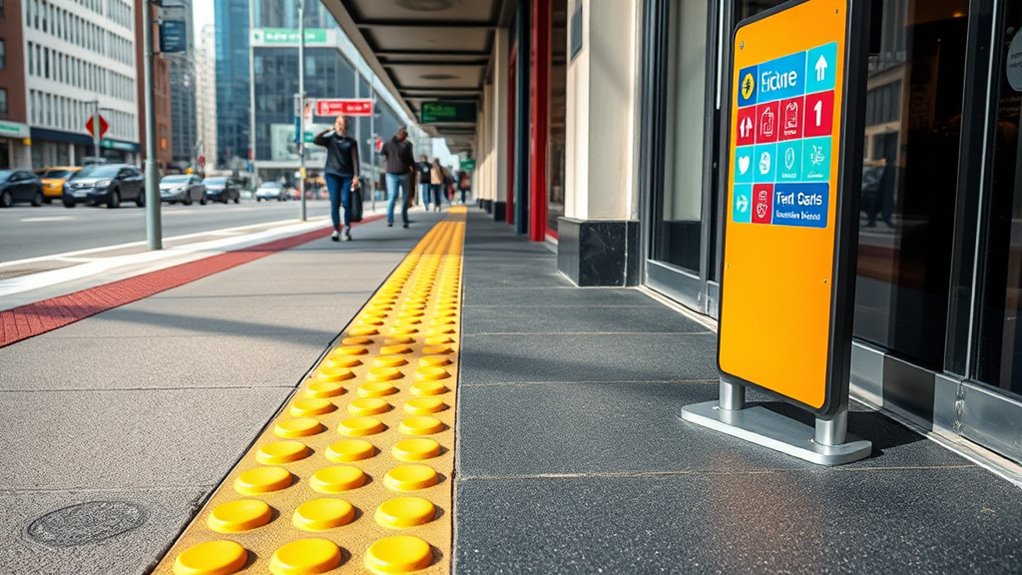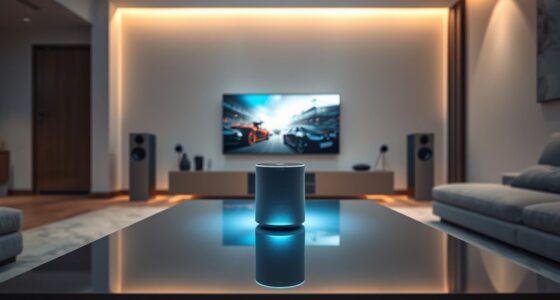To navigate unfamiliar environments effectively, you can use a combination of tactile and visual cues. Tactile paving, like textured surfaces under your feet or cane, signals important features such as crossings and platform edges. Visual cues, including signs and markings, support your understanding of your surroundings. When both cues work together, they help you move independently and confidently. Keep exploring how these systems integrate to improve your wayfinding skills and your overall safety.
Key Takeaways
- Tactile cues like textured paving surfaces guide visually impaired users to crossings and pathways through touch detection.
- Auditory signals such as announcements and sounds provide real-time information about crossings and environment changes.
- Combining tactile and auditory cues creates a comprehensive, reliable wayfinding system that enhances navigation confidence.
- Standardized patterns and sounds ensure consistent recognition and interpretation across different locations.
- Using both tactile and visual cues maximizes accessibility, safety, and independence in complex or unfamiliar environments.

Have you ever wondered how people find their way in unfamiliar places? Navigating new environments can be challenging, especially if you’re relying on limited sensory input. Fortunately, cities and public spaces have developed systems to assist everyone, including those with visual impairments. Tactile paving and auditory signals work together to create a safer, more accessible experience. When you walk along a sidewalk or enter a station, tactile paving often lies beneath your feet, serving as a textured surface that signals important information. These raised patterns, such as truncated domes, alert you that you’re approaching a crossing, platform edge, or a change in direction. The textures are designed to be distinguishable through touch, allowing you to detect them with a cane or even under your shoes. This simple yet effective cue guides you through complex spaces, helping you stay on course and avoid hazards.
Similarly, auditory signals complement tactile cues by providing sound-based navigation assistance. Be they loud buzzers, spoken announcements, or ringing bells, these signals inform you about crossing times, station arrivals, or potential dangers. For example, when a pedestrian light turns green, a distinct beeping sound might indicate it’s safe to cross. If you’re visually impaired, these auditory cues become vital, filling in the gaps that visual information can’t cover. You learn to associate specific sounds with corresponding actions, making your journey smoother and less stressful. Together, tactile paving and auditory signals form a comprehensive system that guides you seamlessly through unfamiliar environments. They work hand in hand, with tactile cues providing constant, physical feedback and auditory signals offering timely, spoken or sound-based instructions.
You might notice that in many urban settings, these systems are intentionally designed to be intuitive. The tactile paving’s patterns and textures are standardized so that you can recognize them across different locations. The auditory signals are synchronized with traffic lights and other environmental cues, creating a cohesive network of information. This synergy ensures that whether you’re walking, using a cane, or relying on hearing, you receive consistent guidance. As you become more familiar with these cues, navigating new places feels less intimidating. You develop confidence in your ability to interpret the signals and make informed decisions based on the tactile and auditory information provided. Ultimately, these tools empower you to move independently, explore new environments, and enjoy your surroundings with greater ease and safety.
Frequently Asked Questions
How Do Tactile Cues Differ for Various Disabilities?
Tactile cues differ based on disabilities by leveraging haptic feedback and sensory substitution. For visually impaired individuals, raised patterns or Braille provide directional info, while haptic feedback through wearables alerts them to obstacles. For those with mobility challenges, tactile cues on floors or handrails guide movement. You can see how customizing tactile cues guarantees effective navigation tailored to each disability, enhancing safety and independence.
What Technologies Complement Tactile and Visual Navigation Aids?
You can enhance tactile and visual navigation aids with assistive apps and smart devices. These tools provide real-time GPS, voice guidance, and obstacle detection, making navigation smoother. Assistive apps integrate with smartphones and wearables, offering personalized directions. Smart devices like smart canes or glasses use sensors and cameras to relay environmental info. Together, they create a thorough system that boosts independence and safety during navigation.
How Can Urban Environments Improve Wayfinding Accessibility?
Did you know that over 70% of urban pedestrians struggle with wayfinding? To improve accessibility, you should advocate for sensor integration in city infrastructure, which offers real-time guidance and obstacle alerts. Encouraging community involvement guarantees diverse needs are considered, creating more inclusive environments. These steps help everyone navigate confidently, making cities safer and more welcoming for people with visual or tactile navigation needs.
Are There Cultural Differences in Tactile and Visual Signage?
Yes, cultural differences influence tactile and visual signage. You’ll notice that cultural symbolism shapes signage design, affecting how symbols and colors are interpreted. In some cultures, certain colors or icons carry specific meanings, so you should consider these factors when designing signage for diverse audiences. By understanding local cultural symbolism, you can create more effective wayfinding cues that resonate universally, ensuring everyone navigates safely and comfortably.
What Future Innovations Are Emerging in Navigation Aids?
Future innovations in navigation aids include augmented reality and smart wearables that enhance your wayfinding experience. You’ll find AR glasses or smartphone apps overlaying directions directly onto your environment, making navigation intuitive and seamless. Smart wearables, like wristbands or rings, can provide haptic feedback for directions, reducing reliance on visual cues. These advancements will make navigation more personalized, efficient, and accessible, especially in complex or unfamiliar settings.
Conclusion
By combining tactile and visual cues, you create a navigation system as guiding as a lighthouse in a storm. These cues help you find your way with confidence, whether you’re exploring a new city or maneuvering through a complex building. Remember, just like a compass always points north, effective wayfinding tools keep you on course. Embrace these cues, and you’ll navigate any environment smoothly—turning confusion into clarity with each step you take.









